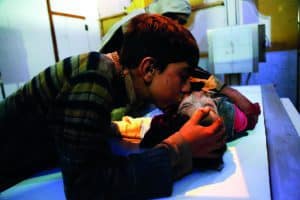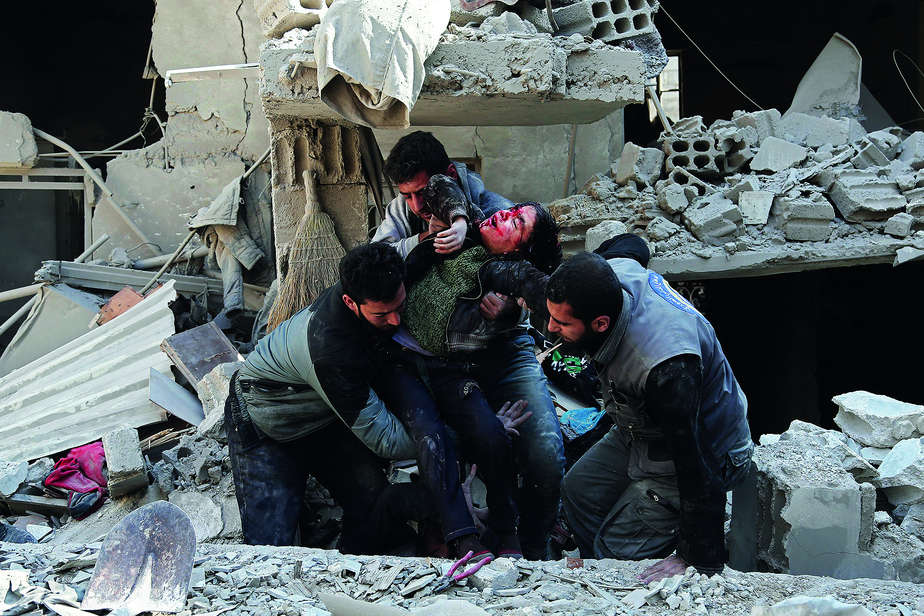The routine exposure to unsanitised war photos on social media has led to normalisation of wartime brutality
Back in 1991, when American photojournalist Kenneth Jarecke returned home after a stint in the raging, dusty battle-plains of Kuwait, he carried with him a highly distressing photograph: a charred Iraqi soldier barely clambering out of his vehicle in a final, futile attempt to save his life. It was an image that no media house in the US wanted to carry.
The photo, taken on the ashened ‘highway of death’ after the bloody US campaign to throw Saddam Hussein’s army out of Kuwait, was apparently too gruesome an image for public consumption. It was a stark departure from the sanitised war photographs that the American press was feeding to its benign consumers at large.
Evidently, how war imagery is distributed has always mattered a lot.
Notwithstanding generic filtering, the post-World War West did see its fair share of raw war imagery. Remember the iconic Napalm Girl of Vietnam? At the time of the image’s publication, it hit the public gaze as a one-off revelation of the crudest, ugliest, and, perhaps, the truest face of war, and had a decisive impact on how the American public viewed its belligerence in Vietnam. Public support for the war began to dip rapidly.
But, the Napalm Girl was a rare exception then. At the end of the day, war reporting remained strictly confined to specific editorial sensibilities. The average news consumer bore witness only to cautiously distilled photographs that projected the aggressor’s narrative of benign, necessary, good-vs-evil warfare with hardly any collateral damage.
Cut to 2018.
Newsrooms don’t own the news cycle anymore, thanks to the internet and smartphones. Hundreds of horrific images, not any less in proportion to the Napalm Girl, are floating around the web. Facebook and Twitter feeds are flooded with explicit images of maimed children, grieving parents, dismembered bodies, mass graves, and shattered buildings. No filtering, distillation, or censoring – save for maybe the Facebook explicit cover that can be removed with a finger tap.
The Napalm Girl is no more the exception now. She is the omnipresent visual war metaphor on everyone’s newsfeed — whether in Texas or Tasmania. She, alongside her fellow innocent victims of war-making, is everywhere.
And Syria seems to be the glacial source for this mighty river of gore.
Since the lengthy civil war began in 2011, Syria has fed the social media news cycle with thousands of macabre images of an unprecedented nature. They have come in bouts, almost like seasonal acid rain on verdant fields. When they came, they managed to shock the average social media user, perhaps even the most stoic and thick-skinned ones.

Be it the first chemical attack in Ghouta in 2013, the bloody siege of eastern Aleppo in 2016, the sarin gas attack in Khan Sheikhoun in 2017, or the ongoing bombing campaign in eastern Ghouta – Syria has numbed the common psyche with tragic unease from time to time.
But, what really is this drip feed of war imagery doing to public sympathy?
Today, it is no dark humour to find, on your Facebook feed, a dozen images of dead or almost-dead children lodged between a meme on Justin Trudeau and a listicle piece on men’s bulges. The Napalm Girl, perhaps better re-christened as the Syrian Girl, is today little more than a 4 seconds halt of the scrolling fingertip. She sits in quiet, pixelated horror between politics and casual voyeurism.
Clearly, a sense of collective apathy is creeping in. We are beginning to get used to wartime brutality.
If one Napalm Girl could push a nation’s conscience over the edge, then why haven’t a thousand Syrian Girls sharpened the collective response? Why do we not see a single global campaign to stop the massacre in Syria? Not even urban demonstrations, like those that happened during the 2003 Iraq War? Despite the bloodstains on every single social media feed, why is the global conversation only mildly dealing with Syria?
Perhaps, and precisely, because of the normative shift in war imagery distribution.
The excessive and routine injection of the Syrian tragedy has had a linear, and rather expected, consequence: large-scale normalisation of wartime brutality. The simple reason why mass civilian deaths in Aleppo do not trigger the same reaction as those in, say, Paris, is because a bulk of us have come about to look at Syria as a seasoned warzone where massive body counts are inevitable. ‘Why wail over mass deaths in a warzone?’
Like a violent, A-rated TV series, we watch the Syrian ordeal with surface emotions and the primordial gusto of watching tragedy. This gaze is intense, but transient and dry. It does not have any lasting consequence.
It would be fair to conclude that Syria has become the quintessential conflict museum for most of us – and this includes even those with relatively higher intellectual capital, like policy analysts, strategic experts, activists, and the rest. What’s more, we are copiously guilty of ambling past. A nice, long, hot war to revel at, after all!
That said, it would be unfair to generalise and extrapolate. We do see social media users draw attention to how mainstream news cycles are apathetic to the Syrian condition. We do see micro-funding campaigns and documentation portals trying to facilitate a shift of global attention to Syria.
But most of these endeavours emanate from a deeper, darker place of confusion, disgust, anger, and helplessness. Those that manage to keep their heads above the water tend to find themselves in a crossfire of post-truth battles (a bonus of webcasted wars): one fake Syria image versus another seemingly true Syria image. One real video of a blood-spattered child against another staged video of trapped civilians. Which one to believe, no one knows. Which one speaks the truth, impossible to learn.
The photo editors of the wars past would be cackling at us today. Perhaps their discretionary editorial censorship did do some good to maintain critical public sympathy. Maybe they understood that a routine dosage of ‘un-sanitised’ war images would ultimately acclimatise the public to the new normal, not unlike how our bodies get used to certain antibiotics on repeated, short-cycle use.
Once that happens, the Napalm Girl would have zero shock value.
But, as distant, puny, unwitting observers of big power politics wreaking havoc in a fractured country, what can one even do? Storm into the Security Council and authorise a peacekeeping mission? Get a brunch appointment with Basher al Assad? Maybe a dinner date with the commander of Al Nusra. Our options are grossly limited.
This article was first published in Newslaundry.





